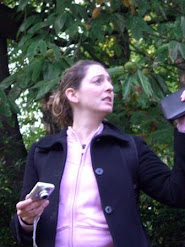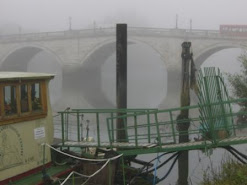‘It’s like being in Palermo,’ ventured my partner Russell, as he pushed open the window to its limited hilt, welcoming in the roar of traffic below. Our room, fuggy with sewage, could use some fresh air, and, as we lay tipsy on the stiff bed, sirens wailing, I had to remember that we were actually on the first night of our holiday in Stratford, not Sicily.
Can anywhere – even our locale – become interesting if we apply the right mindset? When I glimpsed a leaflet, in Clapton’s Springfield Park, suggesting I walk London’s ‘Capital Ring,’ I was curious. ‘Sole-searching’, it punned, ‘discover the heart and soul of London on foot.’ Inside, a map outlined the 78 mile circular route through Woolwich, Crystal Palace, Wimbledon, Richmond, Harrow-on-the-Hill, Stoke Newington, Highgate and Hackney Wick.
We formed a plan: to walk the Ring in a week, 12 miles a day, with each night’s accommodation – a pre-booked jumble of boutique B ‘n’ B’s, chain hotels and opulent riverside palaces – as near as possible to the route; to begin and end in Highgate (geographically convenient); and to raise money for the charity Walk Once More (http://www.walkoncemore.org/), set up by a friend with spinal cord injury. What holiday, we wondered smugly, could be greener?
Rucksacks bulging, a week or so later we closed our front door into the glare of the Saturday morning sun, relishing no airport express, no delays, no glum faces, and, thrillingly, no half-hearted compulsion to drain the historical interest from an unknown city. This adventure would, we decided grandly, give fresh perspective to our lives in the great metropolis. (Sipping a pint in Balham, half way round, we watched sharp-suited commuters, so upright and serious, with a fascination normally reserved for an indigenous people.)
And from the start in Highgate, the Ring, a well sign-posted route which meanders through mostly green spaces, threw up immediate delights, despite the hum of traffic never far away. Near the disused platform of the former Crouch End station, on which you imagine the long dead, lined up for work, a giant sculpture leapt out of the wall. This was a spriggen, a local goblin rumoured to steal human babies. A mythical beast near Finsbury Park? Whatever next – Stonehenge in Hackney?
Well, yes. But before we encountered the vernacular ‘Ackney ‘Enge, originally the base of a pumping engine, other little-known sights slid past: ragged Abney Park Cemetery in Stoke Newington, with its 300,000 graves, and deep earthy smell; a flotilla of painted canal boats at Springfield Marina, and kestrels hovering over Walthamstow Nature Reserve, the last surviving marshlands in London.
We soon learnt a few tricks, though: our lunch of smoked haddock kedgeree and chicken pie was delicious, but the afternoon walk was, groaned Russell, ‘like being pregnant.’ And too much booze was a no-no: a red-wine fuelled first night in Stratford made the second stretch, down to Woolwich, initially rather bleak. But, as we strolled along the river Lea that fuzzy Sunday morning, we soon became imaginers of other people’s lives: why was the Polish man slumped on a bollard by the lock, head in hands? What lurked in the floating bin bags, taut like outsized testicles? Whose was the sodden black hoodie on the bank? Solo rowers swished by, fishermen with dreads smoked reefers to loud reggae music, and a shrill gospel choir rung out besides a long stretch of graffitied wall. I started to think, under the granite sky, about how many lives were going on in this city.
‘So we’re walking on shit’, quipped my brother, who had joined us, as the smell wafted over the breeze. This was the Greenway path, a brambly recreational route from Hackney to Beckton, built over 6 miles of sewage pipes pumping 100 million gallons a day. Although the path offered a vantage point over the low-level, work-in-progress Olympic Park Regeneration area, it looked, for a moment, like a civilization after extinction: cranes rose stiffly over warehouses, whilst skips and tractors squatted on mud, the silence punctured only by the bleep of a lone truck traversing fly tips and scrapyards. Yet, along this unlikely stretch were gems like the Abbey Mills Pumping Station – a Grade II listed, oriental ‘palace’, opened in1868 – known, delightfully, as the ‘Temple of Sewage’.
That afternoon the Woolwich Foot Tunnel, with its stench of urine, ejected us out south of the river, where the awe-inspiring metal of the Thames Barrier – ‘Sydney Opera House’, said Russell – gleamed in hazy sun. And now, our trek moved across South East London, a blur of palaces, gardens, and commons, including Charlton House, a splendid Jacobean pile near Blackheath, derelict Sevendroog Castle, built in 1784 and the highest point of the Ring (404ft), and windswept Beckenham Mansion, as grey and forlorn as a widow. Most spectacular, however, was world-class medieval royal residence Eltham Palace, recently restored to art Deco splendour.
By the third day, after a sleepless night in a brand new boutique hotel near Blackheath, aches and pains had predictably blossomed: blisters itched under the skin of our feet; I had been stung by a wasp; and shoulders and lower backs throbbed. Yet nothing was more of a reality check than seeing roadside flowers at regular intervals, so easy to ignore in the flapping urgency of our lives: ‘Bruv – Ben – Cuz,’ read one on Southend Road. ‘Don’t mourn for me. I’m still here, though you don’t see.’
And it was while considering this, the sunlight filtering through the hornbeams, the rattle of woodpeckers in the distance, that I realized there was nothing on my mind. The drum of anxieties had stopped beating. All you have to do is follow the road ahead, I thought, crunching leaves underfoot. It was as simple – and as transient – as the seasons.
But then the weather turned. On the fourth day, leaving the charmingly anachronistic Bromley Court Hotel (‘Crossroads!’ snorted Russell), torrents swept across South London. Under funereal skies we forged ahead, the rain pouring down into the shadowy depths of the wood, gusts rattling the crowns of yellow-leaved oaks. Clocking up 14 miles in four hours, we could only glimpse the dripping dinosaurs in Crystal Palace Park, its landscaped waterfall tropical in the mist, before taking shelter under the green steel girders of the crumbling café, where we sipped hot tea from polystyrene cups. And, after paths on Biggin Wood and Streatham Common had turned into mudslides, we were relieved to be greeted by the B ‘n’ B owner with mirage-like words: ‘I’ve got flapjacks in the oven and the kettle’s on.’ How unexpected it is, I thought, stewing in the bath later, to holiday in London with your needs reduced to the basics: food, water, and rest.
Our remaining journey across South West London chomped through Wimbledon Common, Putney Heath and Richmond Park, where rutting stags, protecting their females, nearly charged at us, and screeching parakeets danced round pines. Long buried teenage memories flooded back: snogs by ponds, Sunday family walks, playing fields where I hid between frowning goalposts, and Russell’s first studio flat, where his neighbour hammered techno music ‘till 6am.’
Most nights we chose simple lodgings, but a must-stay was the elegant Petersham Hotel, with its terrace overlooking cattle grazing in the meadows by the Thames. And early next morning Richmond Bridge, enshrouded in mist, with its clatter of boats, brought to mind Venice, as silhouetted café owners un-stacked chairs with choreographed precision. And eerier still was nearby Isleworth ‘Ait’, a creek that, with the tide out, its barges beached on banks, was as other-worldly as a dead arm of the Mississippi.
Six days after setting off, we had hiked full circle back into North West London. Here the route was almost empty, apart from three middle-aged ladies conquering it in stages: ‘We’re far too busy to do it all in one go!’ they chirruped. Drifting through swathes of suburbia, I realized it was the quiet details that, over the week, had endured in my memory: the former East London slagheap re-named, in upbeat municipal fashion, the Beckton Alps; the all-you-can-eat Chinese meal in Charlton where we were warned to finish one course in its entirety before being allowed another; and drab Brent Reservoir, in Victorian times a fashionable resort called the Welsh Harp.
Our last stop was attractive Harrow-on-The-Hill, a time-capsule town awash with schoolboys in boaters and teachers with mortar boards, yet, we discovered, once a site of pagan worship. ‘At least,’ said Russell after an average dinner, ‘its restaurants have made it into the 1970s.’ Black steak with shallot sauce, anyone?
Highgate’s hilly copses – or Gravel Pit Woods – provided a dramatic climax to the trek, and as we collapsed with a pint, in a kind of blank appreciation of our goal, I was reminded of an information board back in Beckenham Park: ‘Walking in parks and woodland,’ it told us, ‘is a relaxing way of coping with the demands of modern life.’ ‘Solvitur ambulando,’ announced my father, our final guest walker, as he sipped his restorative shandy, before adding: ‘Things are worked out by walking.’
Subscribe to:
Post Comments (Atom)







































1 comment:
How could you have put the most hideous picture of me ever on the site. I look like a 90 year old woman. My photographic skills are pretty impressive though!!
Post a Comment